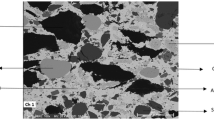Abstract
Previously, we demonstrated a decrease in wear loss of Cu-40%Zn against a steel wheel during bidirectional sliding ascribed to Bauschinger’s effect associated with diminished strain-hardening. However, the situation changed when the alloy was worn by a ceramic-grinding wheel. It was observed that the mass loss continuously increased with reversal of the sliding-direction although the corresponding hardness of worn surface also decreased. In this case, Bauschinger effect still functioned but the failure mode varied, leading to the different trend of response to wear against the ceramic-grinding wheel in comparison with that against the steel counter-face.







Similar content being viewed by others
References
Bauschinger, J.: Ueber die Veränderung der Elasticitätsgrenze und des Elasticitätsmoduls verschiedener Metalle. Civilingenieur 27, 289–348 (1881)
Sowerby, R., Uko, D.K.: A review of certain aspects of the Bauschinger effect in metals. Mater. Sci. Eng. 41, 43–58 (1979)
Bate, P.S., Wilson, D.V.: Analysis of the Bauschinger effect. Acta Mater. 34, 1097–1105 (1986)
Daniel, R.C., Horne, G.T.: The Bauschinger effect and cyclic hardening in copper. Metal. Mater. Trans B 2, 1161–1172 (1971)
Boger, R.K., Wagoner, R.H., Barlat, F., Lee, M.G., Chung, K.: Continuous, large strain, tension/compression testing of sheet material. Int. J. Plast. 21, 2319–2343 (2005)
Kuwabara, T., Kumano, Y., Ziegelheim, J., Kurosaki, I.: Tension-compression asymmetry of phosphor bronze for electronic parts and its effect on bending behavior. Int. J. Plast. 25, 1759–1776 (2009)
Tan, Z., Magnusson, C.: The bauschinger effect in compression-tension of sheet metals. Mater. Sci. Eng. A. 183, 31–38 (1994)
Abel, A.: Historical perspectives and some of the main features of the Bauschinger effect. Mater. Forum 10, 11–26 (1987)
Brown, L.M.: Dislocation plasticity in persistent slip bands. Mater. Sci. and Eng. A 285, 35–42 (2000)
Srivatsan, T.S.: The low-cycle fatigue and cyclic fracture behaviour of 7150 aluminium alloy. Int. J. Fatigue 13, 313–321 (1991)
Srivatsan, T.S., Hoff, T.: The high strain cyclic fatigue and fracture behaviour of 2090 aluminum alloy. Eng. Fract. Mech. 40, 297–309 (1991)
Maier, H.J., Renner, H., Mughrabi, H.: Local lattice-parameter measurements in cyclically deformed copper by convergent-beam electron-diffraction. Ultramicroscopy 51, 136–145 (1991)
Hecker, M., Thiele, E., Holste, C.: X-ray diffraction analysis of internal stresses in the dislocation structure of cyclically deformed nickel single crystals. Mater. Sci. Eng. A 234, 806–809 (1997)
Yue, L., Zhang, H., Li, D.Y.: A molecular dynamics study of nano twined copper under two-directional sliding. Scripta Mater. 63, 1116–1119 (2010)
Stewart, D., Cheong, K.S.: Molecular dynamics simulations of dislocations and nanocrystals. Curr. Appl. Phys. 8, 494–497 (2008)
Wu, P., Xu, X., Rengarajan, V., Zwiebackb, I.: Propagation and density reduction of threading dislocations in SiC crystals during sublimation growth silicon carbide 2008. Mater. Process. Devices 1069, 83–88 (2008)
Nye, J.F.: Unfolding higher-order wave dislocation clusters and catastrophe theory. J. Opt. A Pure Appl. Opt. 10, 075010 (2008)
Fang, H., Horstemeyer, M.F., Baskes, M.I., Solanki, K.: Atomistic simulations of Bauschinger effects of metals with high angle and low angle grain boundaries. Comput. Methods Appl. Mech. Eng. 193, 1789–1802 (2004)
Tang, C.Y., Li, D.Y., Wen, G.W.: Bauschinger’s effect in wear of materials. Tribol. Lett. 41, 569–572 (2011)
Finkin, E.F.: Speculations on the theory of adhesive wear. Wear 21, 103–114 (1972)
Pacchioni, G., Rosch, N.: Supported nickel and copper clusters on MgO(100): a first-principles calculation on the metal/oxide interface. J. Chem. Phys. 104, 7329–7337 (1996)
Sahoo, Prasanta: Adhesive friction for elastic–plastic contacting rough surfaces considering asperity interaction. J. Phys. D Appl. Phys. 39, 2809–2818 (2006)
Alpas, A.T., Zhang, J.: Effect of microstructure (particulate size and volume fraction) and counterface material on the sliding wear resistance of particulate-reinforced aluminum matrix composites metal. Mater. Trans. A 25, 969–983 (1994)
Schwarz, K.W.: Simulation of dislocations on the mesoscopic scale. I. Methods and examples. J. Appl. Phys. 85, 108–119 (1999)
Dewit, G., Koehler, J.S.: Interaction of dislocations with an applied stress in anisotropic crystals. Phys. Rev. 116, 1113–1120 (1959)
Schwarz, K.W., Tu, Y.: Dislocation-interaction-based model of strained-layer relaxation. J. Appl. Phys. 106, 083510 (2009)
Zhang, Z.F., Wang, Z.G.: Relationship between the fatigue cracking probability and the grain-boundary category Philos. Mag. Lett. 80, 483–488 (2000)
Bjerken, C., Melin, S.: A study of the influence of grain boundaries on short crack growth during varying load using a dislocation technique. Eng. Fract. Mech. 71, 2215–2227 (2004)
Shi, J., Zikry, M.A.: Grain-boundary interactions and orientation effects on crack behavior in polycrystalline aggregates. Int. J. Solid. Struct. 46, 3914–3925 (2009)
Wang, N., Wang, Z.R., Aust, K.T., Erb, U.: Effect of grain size on mechanical properties of nanocrystalline materials. Acta Metal. Mater. 43, 519–528 (1995)
Meyers, M.A., Mishra, A., Benson, D.J.: Mechanical properties of nanocrystalline materials. Prog. Mater. Sci. 51, 427–556 (2006)
Armstrong, R.W.: From {110} cracking in MgO to model strength evaluations. Mater. Sci. Eng. A 409, 24–31 (2005)
Paidar, V.: Sliding mechanism of FCC/BCC interphase boundaries. Mater. Sci. Forum 294, 637–640 (1999)
Rabinowicz, E.: Friction and wear of materials, 2nd edn. John Wiley & Sons Inc, New York (1995)
Author information
Authors and Affiliations
Corresponding author
Rights and permissions
About this article
Cite this article
Tang, C., Li, D.Y. & Wen, G.W. A Follow-up Study on Bauschinger’s Effect in Bidirectional Wear of Cu-40%Zn against Different Types of Counter-Face. Tribol Lett 43, 101–106 (2011). https://doi.org/10.1007/s11249-011-9790-x
Received:
Accepted:
Published:
Issue Date:
DOI: https://doi.org/10.1007/s11249-011-9790-x




